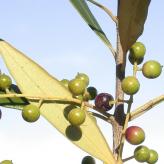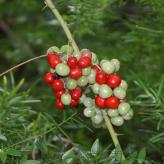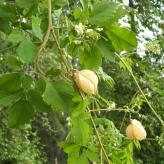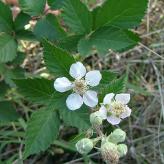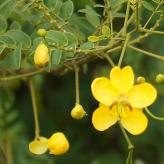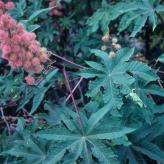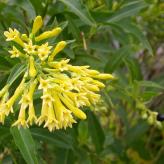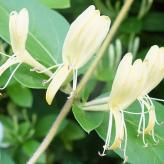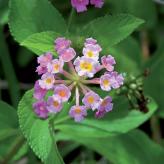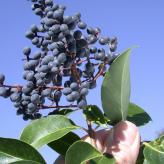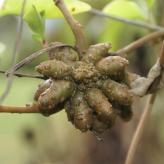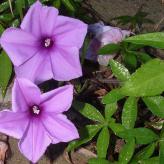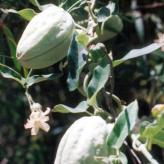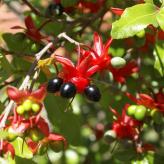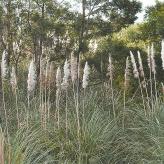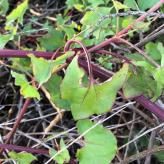- Home
- Environment
- Weeds, Pests and Nuisance Native Animals
Weeds, Pests and Nuisance Native Animals
Invasive species – plants and animals – that have entered Australia from elsewhere, and which now cause economic, social or environmental harm.
Weeds You Need to Control
Weeds are plants that are not wanted within a specified area and have the ability to germinate, establish and spread without human intervention. They are able to displace desired vegetation and often grow in locations not suited to their habit such as small trees growing out of cracks in pavements etc. Weeds are largely found in unmanaged areas of private and public lands and can be difficult to remove once established.
Council actively manages weeds throughout the Mosman Local Government Area through several operational contracts and through inspection by Council Officers on private property. Council is the Local Control Authority and private property inspections are focused on those properties that are directly adjacent to Council’s natural assets or on properties where an enquiry has been received regarding weeds.
Weeds in Mosman are categorised by their Biosecurity Risk and ability to spread from their intended location.
Biosecurity Weeds
Biosecurity Weeds (formerly called noxious weeds) are rated differently through the separate Local Government Areas and are categorised into 5 Risk Ratings within Mosman. The rating will determine the required course of action to be taken. If a notice is received for a biosecurity weed, the identified weed must legally be controlled or removed by the property occupier. Weeds that are declared a biosecurity risk may be a threat to human health, the environment or the agriculture industry. Council has powers to issue notices to property owners/occupiers requiring removal of plants under the Biosecurity Act 2015.
Biosecurity Weeds are placed into the following categories;
Risk Rating 1 – Very High Risk – Prohibited Weeds
“The plant must be eradicated from the land and the land must be kept free of the plant.”
Risk Rating 2 – High Risk – Prohibited Weeds
“The plant must be eradicated from the land and the land must be kept free of the plant.”
Risk Rating 3 – Medium Risk – Controlled Weeds
“The plant must be fully and continuously suppressed and destroyed.”
Risk Rating 4 – Marginal Risk – Controlled Weeds
“The growth of the plant must be managed in a manner that continuously inhibits the ability of the plant to spread and the plant must not be sold, propagated or knowingly distributed.”
Risk Rating 5 – Low Risk – Restricted Plants
“The growth of the plant must be managed in a manner that continuously inhibits the ability of the plant to spread and the plant must not be sold, propagated or knowingly distributed.”
NSW Weed Wise Search – Dep Primary Industries
Below are images of commonly occurring plants within the Mosman LGA that may be considered a biosecurity risk. For the complete list in our region please refer to the Greater Sydney Region Strategic Weed Management Plan.
Biosecurity and Environmental Weeds
Environmental weeds can still be classed as a biosecurity risk. Environmental weeds are plants that establish easily and invade natural areas including gardens. As such, construction sites are to be kept free of these plants along with plants declared a Biosecurity Risk in the Mosman LGA.
Weed list adapted from Australian Association of Bush Regenerators, ‘Bushland Weeds of Sydney.’
| Scientific name | Common name | Scientific name | Common name |
|---|---|---|---|
| Acacia baileyana | Cootamundra Wattle | Leycesteria formosa | Himalayan Honeysuckle |
| Acacia podalyriiflolia | Queensland Wattle | Lilium formosanum | Taiwan Lily |
| Acacia saligna | Golden Wreath Wattle | Myrsiphyllum asparagoides | Baby Smilax |
| Acer negundo | Box Elder | Nephrolepis cordifolia | Fishbone Fern |
| Ageratina adenophora | Crofton Weed | Parietaria judaica | Asthma weed |
| Ageratina riparia | Mistflower | Paraserianthes lophantha | Crested Wattle |
| Alectryon tomentosus | Woolly Rambutan | Parthenocissus quinquefolia | Virginia Creeper |
| Andropogon virginicus | Whisky Grass | Paspalum distichum | Water Couch |
| Bidens pilosa | Farmers Friend | Passiflora edulis | Passionfruit |
| Bryophyllum delagoense | Mother-Of-millions | Pavonia hastata | Pavonia |
| Cabomba caroliniana | Cabomba, Fanwort | Pennesetum spp. | Fountain grass |
| Caesalpinia decapetala | Mysore Thorn | Persicaria capitata | Japanese Knotweed |
| Chlorophytum comosum | Ribbon Plant | Phoenix canariensis | Canary Island Palm |
| Cinnamomum camphora | Camphor Laurel | Phytolacca octandra | Inkweed |
| Conyza spp. | Fleabanes | Polygala myrtifolia | Polygala |
| Coprosma repens | Mirror Plant | Prunus cerasus | Sour Cherry |
| Coreopsis lanceolata | “Calliopsis” | Psoralea pinnata | African Scurf-pea |
| Cotoneaster spp. | Cotoneaster | Pyracantha angustifolia | Firethorn |
| Crocosmia X crocosmiiflora | Montbretia | Rhaphiolepis indica | Cherry Laurel Indian Hawthorn |
| Dietes bicolor | Dietes | Robinia pseudoacacia | Black Locust |
| Dimorphotheca spp. | Cape Marigold | Salix spp. | Willow, Osier, Pussy Willow |
| Ehrharta erecta | Panic Veldtgrass | Salpichroa origanifolia | Pampas Lily of the Valley |
| Ehrharta longiflora | Annual Veldtgrass | Sapium sebiferum | Chinese Tallow |
| Erica lusitanica | Spanish Heath | Setaria geniculata var pauciseta | Slender Pigeon Grass |
| Erigeron karvinskianus | Seaside Daisy | Sida rhombifolia | Paddy’s Lucerne |
| Erythrina crista-galli | Cockspur Coral Tree | Solanum jasminoides | Potato Vine |
| Fiedychium gardnerianum | Yellow Ginger Lily | Sporobulus africanus | Parramatta Grass |
| Foeniculum vulgare | Fennel | Tephrosia grandiflora | False Swainsonia |
| Gomphocarpus physocarpus | Balloon Cotton Bush | Thunbergia alata | Black-eyed Susan |
| Hydrocotyle bonariensis | Kurnell Curse | Tillandsia usneoides | Spanish Moss |
| Ilex aquifolium | Holly | Tradescantia albiflora | Wandering Jew |
| Impatiens cv | Balsam, Snapweed, Busy Lizzie | Verbena bonariensis | Purple Top |
| Watsonia meriana cv. Bulbillifera | Bugle Lily, Common Watsonia |
What do I do if I believe I or a neighbour has a plant that is a Biosecurity Risk?
You can contact Council for information regarding the actions or treatment required. Information can also be found on the websites below.
Further information
Rabbits
Feral rabbits are an ongoing concern for Mosman residents because of the damage they cause to lawns, garden beds and vegetable gardens. Mosman Council is committed to controlling the feral rabbit population on public land through a year round program of integrated pest management.
Rabbits can adapt to a wide range of habitats and prefer short grassed areas or areas containing harbour such as under rock shelves, fallen logs or in dense vegetation in bushland. In an urban environment, they often take up residence under houses, where the dwelling is elevated or there are floor cavities, such as the bungalow style houses found in Mosman. Where possible, ensure access to these areas on your property is sealed.
Where rabbits are causing damage on private property Council can assist the resident by loaning a cage trap for use on their land (conditions apply – see ‘Rabbit Cage Trapping – Conditions and Procedures’ and ‘Rabbit Trap Agreement Of Use’).
For more information contact the Team Leader Open & Biodiversity on 9978 4045 or council@mosman.nsw.gov.au
Rats
Rats are a well-known urban pest, but uncommon in a properly maintained environment. There are two methods that can be used to control rats on your property. These methods are either live trap or lethal traps.
Live traps are those that do not kill the animal. Due to the stress the animal suffers while confined, this is the least preferred method however this can be managed by regularly checking the trap. Once trapped, the trapped rat will need to be humanely euthanised.
Lethal Traps are those that kill the animal and are considered the most humane method. The RSPCA recommends the use of snap traps. Ensure the trap is well-made and of suitable size for the target animal. Traps should be regularly checked each morning to ensure trapped animals are dead.
To reduce your chances of developing a rat problem you can do the following:
In your home
- Store loose food, including pet food, in secure plastic, glass or metal containers with tight lids.
- Do not leave food out overnight, including pet food.
- Secure your property: check for holes and cracks in your walls and make sure you have screens on your windows and doors.
Outside your home
- Remove weeds and debris from around buildings to reduce hiding opportunities.
- Store firewood, garden supplies and other materials on elevated platforms. Eliminate other nesting opportunities.
- Store rubbish in council provided bins. Waste should be stored in metal or plastic bins with secure lids.
Is the rat native?
Local land managers have been involved in the reintroduction of a native bush rat back into the regions’ bushland areas in an effort to drive out the introduced Black Rat. The bush rat, or Bogul, prefers a dense bushland setting so is unlikely to be found in homes and gardens. Still it is important to be aware of their presence and physical similarities.
To those unfamiliar with it, the native Ringtail Possum can also be mistaken for a rat.
For more information
Bees and Wasps
Bees and wasps can be a cause for concern, particularly for those allergic to their stings. They are more active during the warmer months when pollen is more abundant in the environment.
Solitary bees and wasps are rarely cause for concern but should be treated with respect and a safe distance where possible. There are a number of solitary bees that are native to Australia and are stingless.
When a nest is formed on private property, it is the responsibility of the owner or tenant to have the nest removed. While it is possible for anyone to remove a nest, it is recommended that a professional pest controller treat the nest. A qualified pest controller will have the proper equipment and techniques to deal with the problem safely and ethically.
On council land and buildings, please notify council so that it can be removed as soon as possible.
Termites
Termites can cause significant damage to buildings and other structures by feeding on the wood components. Once in the urban environment, they will also feed on paper, fabric and other plant derived materials.
For any new structure that is susceptible to termite attack, the owner is required to install a termite barrier during the construction process. This is not a full proof solution, so the following steps will help provide effective control:
- Regular inspect and maintain vulnerable structures.
- Allow for easy access and good ventilation of sub-floor cavities.
- Fix leaking pipes and fixtures, including gutters, to keep a dry environment and prevent wood rot.
- Clear around structures ensuring the slab is free of soil and other debris.
Council will control termites in its built up areas including street trees. It will not however treat or remove termites in natural/ park areas. It is the responsibility of the property owner to protect their property against termite attack.
Common Myna
Often referred to as the Indian Myna, these birds originate from South Asia. They are sometimes confused with the Noisy Miner, a native honey eater of no relation. The Common Myna is easily recognised by its black head, brown body and yellow mask and bill.
As opportunistic feeders, Common Mynas are attracted to outdoor food sources, such as cafes, picnic areas and backyards. Once established in these areas, they can become an annoyance to the public and drive out native birds and other wildlife.
If you are noticing Common Mynas on your property the first step is to remove potential food sources. Do not leave food out for pets or wildlife and ensure that all food scraps are collected after eating outdoors. Make sure your garbage bins and compost are covered.
To prevent breeding opportunities, undertake building proofing measures to prevent Common Mynas from nesting or roosting on your property. In addition, plant native trees and shrubs to remove roosts from your garden. Common Mynas favour exotic trees with dense foliage, particularly palms.
Nuisance Native Animals
There are a number of native animals that may be considered by some persons to be a pest in the urban environment. They can damage gardens and property and disturb us with their nocturnal activities.
It is important to remember that all native wildlife is protected under the Biodiversity Conservation Act 2016. By clearing and fragmenting their habitat for development, people are driving wildlife into urban areas creating these conflicts.
The best approach is to try and coexist with native fauna. This can be a rewarding and educational experience.
As a general guideline, do not feed wildlife as this will attract them to your yard and create an expectation to be fed. Instead plant locally sourced native plants to provide foraging opportunities for a range of native animals.
For sick or injured animals contact Sydney Wildlife or WIRES.
Brush Turkeys (Alectura lathami)
The Australian Brush Turkey has been making a return to the urbanised areas of Sydney over the last few decades. They have become quite common in the Mosman area since 2010. As the population increases, it is becoming more common in backyards, disturbing gardens in the process.
It is important to note Brush Turkeys are a native animal protected under Part 2 of the Biodiversity Conservation Act 2016. It is illegal to harm a protected animal and this may include the removal of the animal from its natural habitat. As such Council does not remove or relocate Brush Turkeys on private or public land.
Their presence, if planned and managed for, can be beneficial as they provide natural pest control against insects and snails. The following tips can help you maintain a Brush Turkey friendly garden:
- If you have the space, allow an area of the garden for Brush Turkeys to be active to distract them from the rest of the yard. They will only build nests in high shade areas, under a tree. Provide them with mulch to make nests in these areas.
- Plant out garden beds with dense, low-growing native ground covers and place logs and branches to deter scratching in valued areas.
- Alternatively, use coarse mulch that is hard to scratch up or peg chicken wire over the beds to prevent scratching.
- Plant only when Brush Turkeys’ are not actively nest building (February – August). The earlier the better, to give plants time to establish.
- Use plant guards around particularly valuable or vulnerable plants.
Native fauna is managed by National Parks and Wildlife Services and they can be contacted on (02) 9995 5000 or info@environment.nsw.gov.au
For more information
Flying Foxes (Pteropus spp.)
There are three species of Flying Fox commonly found in Sydney. Of these the Grey-headed Flying Fox (Pteropus poliocephalus) is most commonly encountered in urban areas. The Grey-headed Flying Fox is listed as vulnerable under Threatened Species legislation making it a crime to interfere with it.
Flying Foxes primarily eat fruit and nectar and are responsible for the pollination of many of the significant native plants, particularly Eucalypts on the east coast of Australia.
Flying Foxes are nocturnal and it is their nocturnal activities that are a problem in urban environments. They seek out flowering and fruiting trees where they spend the night feeding. During this time they can cause disturbance through excessive noise, high pitched screeching and chattering, and create a mess under their chosen tree. In these instances, the Flying Foxes will only be in the area for the few weeks of the year that the tree is a viable food source.
If you have fruit trees that you wish to protect there are a number of methods that you can implement that will not cause injury to the Flying Foxes.
Flying Foxes and Diseases
Flying Foxes on the east coast are carriers for two well-known diseases, the extent of which has been the subject of misinformation. The two diseases are Australian Bat Lussavirus and Hendra Virus.
Australian Bat Lyssavirus, a relative of rabies, affects about 1% of the wild bat population and can be found in both Flying Foxes and Microbats. However, sick or injured bats are much more likely to carry the virus, as their condition could be a result of infection. The virus is spread to humans by direct contact, through bites and scratches.
There have been very few people infected with Australian Bat Lyssavirus. A vaccine exists, and can be delivered post exposure.
Hendra Virus is primarily associated with horses but Flying Foxes are known to carry it. It is believed that horses can contract the virus from bats when they share a paddock with a colony, though the manner of infection is not understood.
There are no known cases of direct Hendra transmission from bats to humans. All cases of human infection have been a result of high exposure to the bodily fluids of infected horses. A vaccine exists for horses which should prevent further transmission to humans.
If you encounter a bat on your property do not try and handle it. Contact one of the wildlife rescue groups active in the area and they will send a qualified rescuer to retrieve the bat. If possible, isolate the animal.
For sick or injured animals contact Sydney Wildlife or WIRES.
Brushtail and Ringtail Possums (Trichosurus vulpecula, Psuudocherius peregrinus)
Possums are nocturnal marsupials native to Australia. They are well adapted to survive in urbanised environments, which set them at odds with people.
If possums have begun occupying your roof there are several steps you can take:
- Provide an alternative habitat arrangement, typically a nest box in a sheltered part of your garden.
- Light your roof cavity to deter the possums from nesting. Quassia chips and blocks of camphor are also a deterrent.
- Locate and seal the point of egress. Do so only after all the possums and any young have left the roof cavity.
- While your roof is unoccupied, prune any tree branches (see Trees) that could allow possums to access your roof.
You can attract the possums to the new nest box by placing the old drey in the nest box and leaving a few pieces of fruit in the vicinity.
Their presence in our homes is due to the lack of tree hollows in the surrounding environment. Suitable hollows for possums can take up to 200 hundred years to form through natural processes. It is important to consider the wide variety of ecosystem functions that native trees provide when planning to remove them.
Possums can do significant damage to fruit trees when in season. The best method is to completely cover at risk trees in shade cloth, pegging it into the ground around the base. Alternatively, you can place paper bags over ripening fruit.
For more information
Last updated Thursday 22 May 2025
Last updated Thursday 22 May 2025
